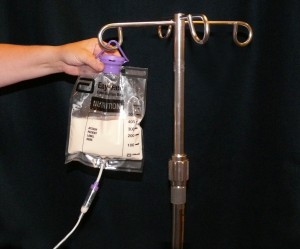John’s Troubleshooting Tip of the Month – Food Pump Series Part 5: Gravity Bag Feeding
 PHS understands how stressful it can be when a piece of equipment isn’t working properly, and we want to help resolve any issues as soon as possible for you. So, once a month, PHS Respiratory Therapist, John Sheahan posts a tip on how to troubleshoot a common error with a piece of equipment.
PHS understands how stressful it can be when a piece of equipment isn’t working properly, and we want to help resolve any issues as soon as possible for you. So, once a month, PHS Respiratory Therapist, John Sheahan posts a tip on how to troubleshoot a common error with a piece of equipment.
This month we will finish up our food pump series by troubleshooting gravity bags.
A gravity bag does not need a pump to deliver formula or breast milk. It is used short term if, after troubleshooting with a PHS clinician, it has been determined that the food pump needs to come in for service. This allows you to feed your child/patient while your replacement pump is being delivered. To make sure you give the right amount of formula or breast milk you must use a simple calculation.
-
- Enter the rate on your food pump into the ___(blank line)___
- Multiply that number by 20
- Divide that number by 60 to give you the number of drips per minute to set using the gravity bag.
- For example if you have a set rate on the food pump of 35 mL**/hr it would look like this:
- 30 x 20 = 600
- 600 divided by 60 = 10 drips per minute.
- **NOTE: If the number is not a whole number round either up or down to the closest whole number.
Once you have figured out the Calculation for Gravity Drip follow these instructions to deliver the right amount of formula or breast milk:
-
-
- Clean workspace and gather supplies.
- Wash hands well.
- If formula is in concentrate or ready to feed form, shake can well.
- Wipe off top of can with clean cloth.
- Close roller clamp on feeding bag.
- Pour formula or breast milk into bag. Close top firmly.
- Hang feeding bag high enough to allow tube feeding to flow by gravity.
- Open roller clamp to fill tubing.
- Close roller clamp. The drip chamber must be half full.
- Flush feeding tube with warm water.
- Have your child sit comfortably in upright position during the feeding.
- Open the roller clamp on the tubing. Use the clamp to adjust the flow rate. Speed up the flow by opening the clamp, or slow down the flow by closing it. If your child has diarrhea or abdominal discomfort, slow down the flow rate.
- After feeding is complete, close all the clamps.
- Disconnect tubing from the feeding tube and flush with warm water.
-
 John Sheahan, RRT-NPS, LRT is a Licensed Respiratory Therapist at PHS and would love to hear from you if you have a tip that you’ve found helps when working with your equipment, or have an idea for a Troubleshooting Tip post. Share your tip or idea through a comment here or an email to John at jcsheahan@pediatrichomeservice.com.
John Sheahan, RRT-NPS, LRT is a Licensed Respiratory Therapist at PHS and would love to hear from you if you have a tip that you’ve found helps when working with your equipment, or have an idea for a Troubleshooting Tip post. Share your tip or idea through a comment here or an email to John at jcsheahan@pediatrichomeservice.com.



